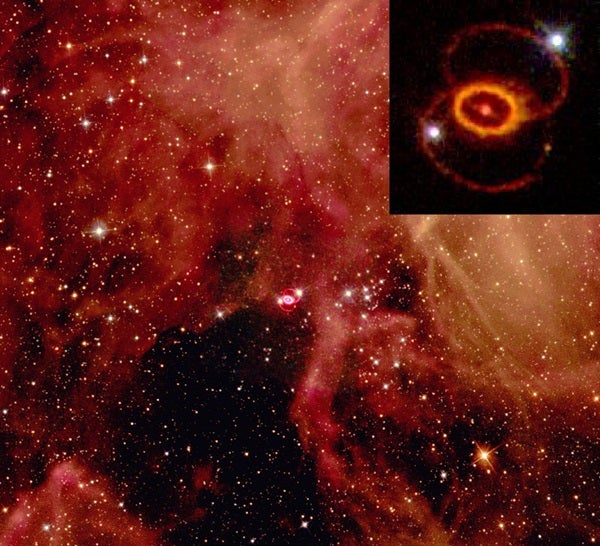A core star collapses when it runs out of the nuclear fuel it depends on and folds in on itself in less than a second under its own huge weight. This process releases enormous amounts of gravitational energy, causing an explosion. A small fraction of the total energy released during a type II supernova — collapse of a lone massive star that burns energy through fusion — is emitted as light. The kinetic energy of the exploding stellar envelope is 10 times greater again, but by far the most energy is carried away by neutrinos. It is by studying these neutrinos, among the most difficult particles to detect, that physicists have come to general agreement that gravitational collapse does start the type II supernova process.
Less understood is whether the outgoing pressure wave causing the explosion — that soon becomes a huge shock wave — travels all the way out and ejects the outer part of the star. Simulations have shown that the prompt shock stalls at distances of about 200 miles (300 kilometers) from the center because of the immense energy required to keep its momentum. Further simulations have found that the shock could restart if the electrons could absorb a small amount of energy — about 1 percent of the neutrino energy available.
Physicists at the University of Aberdeen, Scotland; Science & Technology Facilities Council’s (STFC) Rutherford Appleton Laboratory, United Kingdom; the University of Strathclyde in Glasgow, Scotland; and the Instituto Superior Técnico in Lisbon, Portugal, suggest that the solution to the type II supernovae mystery might lie in a fundamental field long proposed by physicists to answer many important questions. They claim that a component of gravity called the “scalar gravitational field” may be the driving force behind the release of energy that causes the star to finally explode. The existence of scalar fields are predicted but have not yet been detected.
“Scalar fields, unlike electromagnetic fields, do not have a direction. They are needed to explain inflation in the early universe and dark energy in cosmology. They are also being hunted at CERN’s Large Hadron Collider as the Higgs particle, giving rise to the origin of mass. In our case, we believe it is responsible for accelerating particles,” said Bob Bingham from STFC and the University of Strathclyde.
“The theory is that emission of these scalar gravitational waves from the neutron core of a collapsing heavy star may re-energize the stalled shock wave,” said Charles Wang from the University of Aberdeen.
A core star collapses when it runs out of the nuclear fuel it depends on and folds in on itself in less than a second under its own huge weight. This process releases enormous amounts of gravitational energy, causing an explosion. A small fraction of the total energy released during a type II supernova — collapse of a lone massive star that burns energy through fusion — is emitted as light. The kinetic energy of the exploding stellar envelope is 10 times greater again, but by far the most energy is carried away by neutrinos. It is by studying these neutrinos, among the most difficult particles to detect, that physicists have come to general agreement that gravitational collapse does start the type II supernova process.
Less understood is whether the outgoing pressure wave causing the explosion — that soon becomes a huge shock wave — travels all the way out and ejects the outer part of the star. Simulations have shown that the prompt shock stalls at distances of about 200 miles (300 kilometers) from the center because of the immense energy required to keep its momentum. Further simulations have found that the shock could restart if the electrons could absorb a small amount of energy — about 1 percent of the neutrino energy available.
Physicists at the University of Aberdeen, Scotland; Science & Technology Facilities Council’s (STFC) Rutherford Appleton Laboratory, United Kingdom; the University of Strathclyde in Glasgow, Scotland; and the Instituto Superior Técnico in Lisbon, Portugal, suggest that the solution to the type II supernovae mystery might lie in a fundamental field long proposed by physicists to answer many important questions. They claim that a component of gravity called the “scalar gravitational field” may be the driving force behind the release of energy that causes the star to finally explode. The existence of scalar fields are predicted but have not yet been detected.
“Scalar fields, unlike electromagnetic fields, do not have a direction. They are needed to explain inflation in the early universe and dark energy in cosmology. They are also being hunted at CERN’s Large Hadron Collider as the Higgs particle, giving rise to the origin of mass. In our case, we believe it is responsible for accelerating particles,” said Bob Bingham from STFC and the University of Strathclyde.
“The theory is that emission of these scalar gravitational waves from the neutron core of a collapsing heavy star may re-energize the stalled shock wave,” said Charles Wang from the University of Aberdeen.










